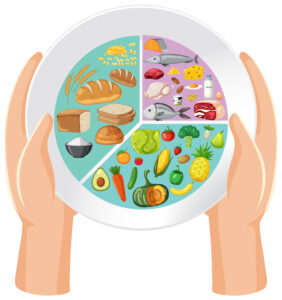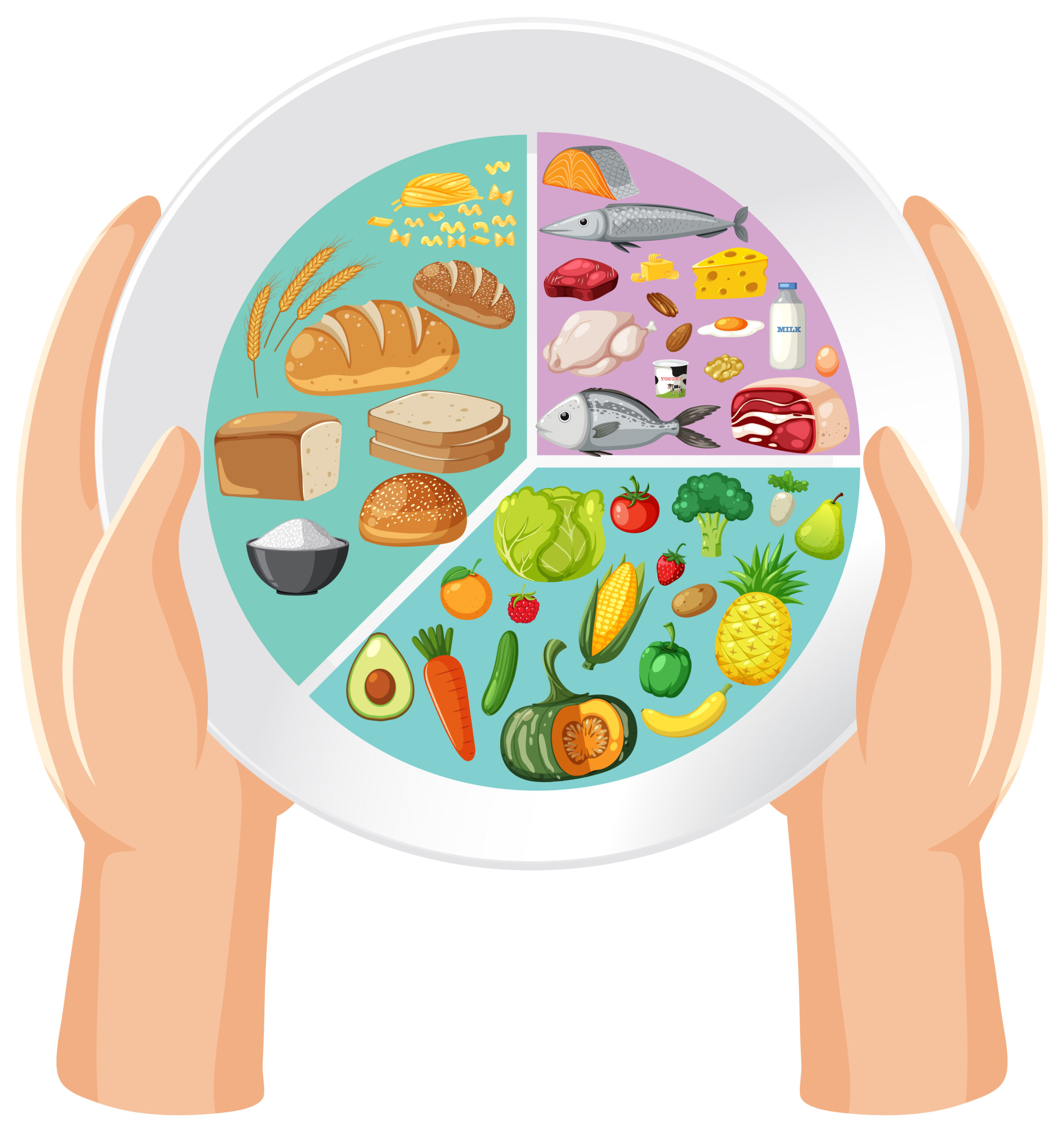Healthy Plate Portion Control Made Easy for a Balanced and Satisfying Diet
Making healthy choices doesn’t have to be complicated. In fact, a simple yet effective tool called the healthy plate method can revolutionize the way you approach portion control. This guide will equip you with the knowledge and strategies to create balanced and satisfying meals using the healthy plate approach.

Why Portion Control Matters
Portion control is a crucial component of a healthy diet. Overeating, even healthy foods, can lead to weight gain and contribute to chronic health conditions. The healthy plate method offers a visual guide to help you make informed decisions about what goes on your plate and how much.
Benefits of the Healthy Plate Method
- Promotes Balanced Eating: The healthy plate encourages you to incorporate various food groups into every meal, ensuring you get the essential nutrients your body needs.
- Simplifies Portion Control: By dividing your plate into specific sections, the healthy plate method eliminates the guesswork of portion sizes.
- Reduces Overeating: The visual cues from the healthy plate help you feel satisfied with a moderate amount of food, preventing overconsumption.
- Easy to Understand and Implement: The healthy plate method is a straightforward approach that can be adopted by people of all ages and backgrounds.
- Promotes Weight Management: By controlling portions, you can manage your calorie intake and create a calorie deficit for healthy weight loss.
Understanding the Healthy Plate
The healthy plate is a visual representation of a balanced meal. Typically, it’s divided into three main sections, with additional space for healthy fats and sometimes a small portion of fruit.
- Non-Starchy Vegetables (Half the Plate): This section is dedicated to low-calorie, nutrient-dense vegetables like broccoli, carrots, leafy greens, peppers, and mushrooms. Filling half your plate with vegetables ensures you get a good dose of vitamins, minerals, and fiber, which keep you feeling full and promote healthy digestion.
- Lean Protein (Quarter of the Plate): This section is for protein sources like chicken, fish, beans, lentils, tofu, or tempeh. Protein is essential for building and repairing tissues, managing hunger hormones, and maintaining muscle mass. Opt for lean protein sources that are lower in saturated fat.
- Whole Grains (Quarter of the Plate): This section is for complex carbohydrates like brown rice, quinoa, whole-wheat pasta, or whole-grain bread. Whole grains provide sustained energy, fiber, and essential vitamins and minerals.
Additional Considerations
- Healthy Fats (Small Portion): Healthy fats like avocados, nuts, seeds, and olive oil are crucial for satiety, hormone regulation, and nutrient absorption. Include a small portion of healthy fats on your plate or as part of your meal.
- Fruits (Optional): While not a mandatory component of the healthy plate, a small serving of fruit can add sweetness and essential vitamins to your meal. Choose whole fruits over fruit juices to avoid added sugars.

Creating Healthy Plate Meals
Here are some tips for creating delicious and satisfying meals using the healthy plate method:
- Variety is Key: Don’t get stuck in a rut! Explore different vegetables, protein sources, and whole grains to keep your meals interesting and ensure you get a variety of nutrients.
- Seasoning is Your Friend: A sprinkle of herbs, spices, or a squeeze of lemon juice can add flavor to your meals without adding extra calories.
- Healthy Cooking Methods: Grilling, baking, roasting, and steaming are healthy cooking methods that preserve nutrients and minimize added fat.
- Read Food Labels: Pay attention to serving sizes on food labels to ensure you’re not overdoing it on seemingly healthy options.
- Plan Your Meals: Having a plan in place can help you resist unhealthy temptations and make healthy choices throughout the day.
Sample Healthy Plate Meals
Here are some examples of meals you can create using the healthy plate method:
- Breakfast: Scrambled eggs with spinach and mushrooms (protein + vegetables), whole-wheat toast (whole grains), and a small apple (optional fruit).
- Lunch: Grilled chicken breast with roasted vegetables (protein + vegetables), brown rice (whole grains), and a drizzle of olive oil (healthy fat).
- Dinner: Salmon with steamed broccoli and quinoa (protein + vegetables + whole grains), and a handful of almonds (healthy fat).
Remember: The healthy plate is a flexible guide. Adjust portion sizes based on your individual needs and activity level. The key is to prioritize nutrient-dense foods and create balanced meals that leave you feeling satisfied without overeating.
Beyond the Plate: Additional Tips for Healthy Eating
While the healthy plate method is a powerful tool for portion control, here are some additional tips to promote healthy eating habits:
- Mindful Eating: Pay attention to hunger and fullness cues. Eat slowly and savor your food, stopping when you feel comfortably full, not stuffed.
- Stay Hydrated: Drinking plenty of water throughout the day can help you feel full and prevent overeating. Aim for eight glasses of water per day.
- Limit Processed Foods: Processed foods are often high in calories, unhealthy fats, sodium, and added sugars. Limit your intake of processed snacks, sugary drinks, and fast food.
- Plan Your Snacks: If you get hungry between meals, plan healthy snacks like fruits, vegetables with hummus, nuts, or yogurt.
- Read Food Labels: Understanding ingredients and serving sizes on food labels helps you make informed choices.
- Cook More Meals at Home: Cooking at home allows you to control ingredients and portion sizes.
- Don’t Skip Meals: Skipping meals can lead to overeating later. Aim for regular meals and healthy snacks throughout the day to keep your metabolism balanced.
- Manage Stress: Chronic stress can contribute to unhealthy eating habits. Find healthy ways to manage stress, such as exercise, yoga, or meditation.
- Get Enough Sleep: When you’re well-rested, you’re better equipped to make healthy food choices. Aim for 7-8 hours of sleep per night.
Making Healthy Eating a Sustainable Lifestyle
Transitioning to a healthy lifestyle doesn’t have to happen overnight. Start by incorporating small changes into your routine. Gradually replace unhealthy choices with healthier options. The healthy plate method is a simple yet effective tool that can help you achieve portion control and create balanced meals. Remember, consistency is key. By making healthy choices most of the time, you’ll be well on your way to a healthier and happier you!
Additional Resources:
- The National Institute of Diabetes and Digestive and Kidney Diseases: https://www.myplate.gov/
- The American Heart Association: https://www.heart.org/en/healthy-living/healthy-eating
- The Academy of Nutrition and Dietetics: https://www.eatright.org/
By incorporating the healthy plate method and these additional tips into your daily routine, you can take control of your portion sizes, make informed food choices, and create a foundation for a healthy and sustainable lifestyle. Remember, a healthy diet is an investment in your well-being. It fuels your body, keeps you energized, and promotes overall health and longevity. So, embrace the healthy plate, enjoy delicious and nutritious meals, and feel the difference a balanced diet can make.

